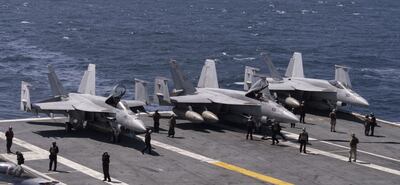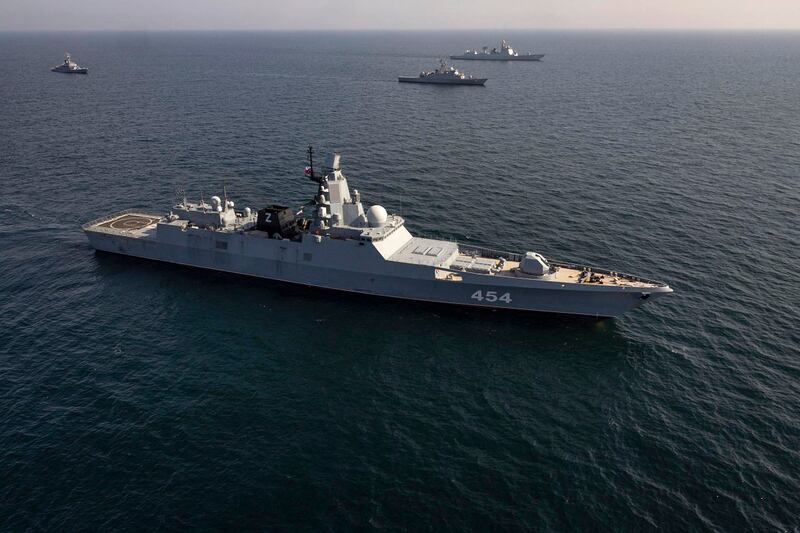A joint military exercise in the Gulf of Oman between troops from China, Russia and Iran enhanced the ability of their navies to conduct diversified maritime missions, officials said on Thursday.
Tan Kefei, a spokesman for China's Defence Ministry, said the drills further deepened friendship and practical co-operation between the three countries.
The three nations sent forces including 12 ships, special operations and diving units to participate in the drills from March 15 to 19, Mr Tan said.
The Chinese Defence Ministry also said that Beijing was willing to work with the Russian military to strengthen strategic communication and co-ordination.
The two countries will work together to implement global security initiatives, Mr Tan said.
He said they would deepen military trust and jointly safeguard international fairness and justice.
They will also organise further maritime, air and other joint exercises, he added.
China President Xi Jinping recently visited Russia and met President Vladimir Putin ― a visit the US denounced.
Mr Tan also said that Australia-Britain-US nuclear submarine co-operation, known as the Aukus pact, may spark an arms race.
"Once Pandora's box is opened, the regional strategic balance will be disrupted, regional security will be seriously threatened," he said.
Changing naval balance
China's People’s Liberation Army Navy is currently the largest navy in the world in terms of numbers of surface vessels, but its operations in the Middle East have to date been limited.
The Pentagon said in January that China’s navy was outbuilding the US and would have 400 ships by 2025. The US navy hopes to have 350 ships by 2035. Amid intensifying competition, the US and China are likely to focus naval power in the Pacific region in the near future, putting strain on the US military presence in the region, which dates back to a 1980s US policy known as the Carter Doctrine.
The policy led to the US basing significant naval power in the region to counter the Soviet Union, and later, Saddam Hussein’s Iraq and post-revolution Iran.
In recent years, that mission has changed to countering piracy, drugs and weapons smuggling, working with allies in a 34-nation naval task force.

The US maintains a large naval base in Bahrain, the headquarters of the Fifth Fleet, which operates over 2.5 million square kilometres in the Arabian Gulf, Red Sea, Gulf of Oman and parts of the Indian Ocean.
About seven US carrier groups are currently at sea, according to the US navy. None are these are in the Middle East, while four are in the Pacific region.
Rival alliance
US Chairman of the Joint Chiefs of Staff Gen Mark Milley told Congress on Wednesday that Iran, Russia and China were strengthening military co-operation.
“I wouldn’t call it a true full alliance in the real meaning of that word, but we are seeing them moving closer together, and that’s troublesome,” Gen Milley said.
China currently operates three aircraft carriers, powered by fossil fuel propulsion, while the US has 11 nuclear-powered aircraft carriers, including the largest in the world, which is capable of carrying about 80 fighter aircraft and bombers.
Beijing’s rivals in the Pacific, such as Japan, have countered its naval expansion by launching their own military build-ups. Japan, which is co-ordinating more closely with countries in Nato, is building new aircraft carriers and co-operating on new fighter jet programmes.
Australia has recently been brought into the fold through the multibillion-dollar Aukaus pact to build nuclear submarines with the US and UK.
It is not clear whether these developments could lead to a greater Russian and Chinese presence in the Middle East.
Russia, which operates a naval base in Tartus, Syria, has about 185 active surface vessels and nearly 60 submarines, many of them nuclear powered. The country operates one aircraft carrier, the Admiral Kusetsov.
Iran, meanwhile, has focused on building large numbers of small, highly mobile missile-armed boats, part of a strategy to swarm and overwhelm a naval rival such as the US, but in recent years has increasingly launched larger vessels, including the multi-hulled, trimaran missile boats developed under its so-called Project Hormuz.







